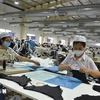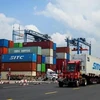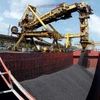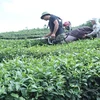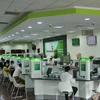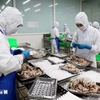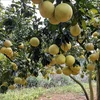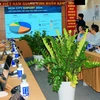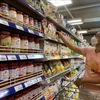Trade experts calculate that Vietnam could be faced with a range of opportunities to accelerate trade with the US this year but first the country needs to introduce a number of shrewd and appropriate solutions to negotiate various technical barriers brought in by the US market.
As the power house behind the world’s economy, each year the US imports a mammoth amount of goods, worth approximately 2 trillion USD, with general materials for production accounting for 30.4 percent, consumer goods 31.8 percent and raw materials for industry 32.9 percent.
As well as providing these figures, Tran Duy Dong from the Ministry of Industry and Trade’s America Department, reported that since Vietnam and the US signed a bilateral trade agreement in 2001, two-way trade between the two countries has spiralled from 1 billion USD in 2001 to 12 billion USD in 2008.
Vietnam’s major export lines to the US are mainly garments and textiles, footwear, wooden furniture, electronics, coffee and tea.
However, in 2009 when the world experienced an economic crisis, bilateral trade suffered a considerable set-back, reflected in a decrease of 4.3 percent in value compared with 2008. The decrease, which was the lowest level recorded amongst exporters to the US, left the two way trade value standing at 11.4 billion USD.
However in the first two months of this year, Vietnam’s exports to the US have bounced back, registering an 18 percent year-on-year rise in garments and textiles (820 million USD), a 38.5 percent surge in timber and wooden furniture (172 million USD) and a 36.5 percent increase in seafood.
On seeing this growth trend, the Vietnamese Ministry of Trade and Industry has forecast that the country’s exports to the US this year would post at least a 10 percent increase over 2009.
Despite the optimistic views on the prospects of the country’s exports to the vast US market, there remain some very real technical barriers that have already affected Vietnamese exporters and will continue to do so in the future.
After the storm of the recent economic crisis, the US was forced to revise its economic policy, including the establishing more technical barriers and imposing anti-dumping taxes on imported goods to protect it’s domestically made products and cutting its volume of imports.
One example is the case of Vietnamese tra and basa fish. Even though these products are currently suffering losses from anti-dumping taxes, the US Department of Agriculture (USDA) intends to reclassify them as “catfish” with the aim of putting them under the direct supervision of the Farm Bill.
Under the terms of the Farm Bill, Vietnamese tra and basa fish eligible for export to the US market must be raised in line with the standards applied to catfish bred in the north-eastern region of the US.
This will cause huge difficulties for Vietnam’s tra and basa fish exporters as the country’s methods of breeding the fish are different from those in the US.
In addition to the Farm Bill, Vietnamese seafood is also facing anti-bioterrorism regulations mandated by the Food and Drugs Agency.
The Lacey Act, which came into effect on April 1, requires the exporters of timber and wooden products to prove the origin of the timber and supplementary materials for the safety of users, which puts the squeeze on Vietnamese exporters even further as they will see their market share in the US dwindle.
According to Tran Duy Dong, raising the competitiveness of Vietnamese garments, footwear and seafood is one of the solutions that will boost the country’s exports to the US. Although these products have found a niche in the US market, they still face serious pressure from their Chinese, Indian, Brazilian and Thai rivals.
He also suggested boosting the export of new products, including plastic ware and special Vietnamese fruits like dragon fruit, litchi and longan.
As the US is a choosy market, Vietnamese businesses need to frequently update themselves with the latest US regulations and should enter partnerships with US importers to facilitate the marketing and distribution of imported goods as well as payment.
Having been in the US for a long time, Vietnam ’s commercial counselor Ngo Van Thoan said, “When overcoming technical barriers, it is necessary to introduce technical measures, which include enhancing technical skills and improving the environment as well as the working condition of employees.”/.
As the power house behind the world’s economy, each year the US imports a mammoth amount of goods, worth approximately 2 trillion USD, with general materials for production accounting for 30.4 percent, consumer goods 31.8 percent and raw materials for industry 32.9 percent.
As well as providing these figures, Tran Duy Dong from the Ministry of Industry and Trade’s America Department, reported that since Vietnam and the US signed a bilateral trade agreement in 2001, two-way trade between the two countries has spiralled from 1 billion USD in 2001 to 12 billion USD in 2008.
Vietnam’s major export lines to the US are mainly garments and textiles, footwear, wooden furniture, electronics, coffee and tea.
However, in 2009 when the world experienced an economic crisis, bilateral trade suffered a considerable set-back, reflected in a decrease of 4.3 percent in value compared with 2008. The decrease, which was the lowest level recorded amongst exporters to the US, left the two way trade value standing at 11.4 billion USD.
However in the first two months of this year, Vietnam’s exports to the US have bounced back, registering an 18 percent year-on-year rise in garments and textiles (820 million USD), a 38.5 percent surge in timber and wooden furniture (172 million USD) and a 36.5 percent increase in seafood.
On seeing this growth trend, the Vietnamese Ministry of Trade and Industry has forecast that the country’s exports to the US this year would post at least a 10 percent increase over 2009.
Despite the optimistic views on the prospects of the country’s exports to the vast US market, there remain some very real technical barriers that have already affected Vietnamese exporters and will continue to do so in the future.
After the storm of the recent economic crisis, the US was forced to revise its economic policy, including the establishing more technical barriers and imposing anti-dumping taxes on imported goods to protect it’s domestically made products and cutting its volume of imports.
One example is the case of Vietnamese tra and basa fish. Even though these products are currently suffering losses from anti-dumping taxes, the US Department of Agriculture (USDA) intends to reclassify them as “catfish” with the aim of putting them under the direct supervision of the Farm Bill.
Under the terms of the Farm Bill, Vietnamese tra and basa fish eligible for export to the US market must be raised in line with the standards applied to catfish bred in the north-eastern region of the US.
This will cause huge difficulties for Vietnam’s tra and basa fish exporters as the country’s methods of breeding the fish are different from those in the US.
In addition to the Farm Bill, Vietnamese seafood is also facing anti-bioterrorism regulations mandated by the Food and Drugs Agency.
The Lacey Act, which came into effect on April 1, requires the exporters of timber and wooden products to prove the origin of the timber and supplementary materials for the safety of users, which puts the squeeze on Vietnamese exporters even further as they will see their market share in the US dwindle.
According to Tran Duy Dong, raising the competitiveness of Vietnamese garments, footwear and seafood is one of the solutions that will boost the country’s exports to the US. Although these products have found a niche in the US market, they still face serious pressure from their Chinese, Indian, Brazilian and Thai rivals.
He also suggested boosting the export of new products, including plastic ware and special Vietnamese fruits like dragon fruit, litchi and longan.
As the US is a choosy market, Vietnamese businesses need to frequently update themselves with the latest US regulations and should enter partnerships with US importers to facilitate the marketing and distribution of imported goods as well as payment.
Having been in the US for a long time, Vietnam ’s commercial counselor Ngo Van Thoan said, “When overcoming technical barriers, it is necessary to introduce technical measures, which include enhancing technical skills and improving the environment as well as the working condition of employees.”/.
